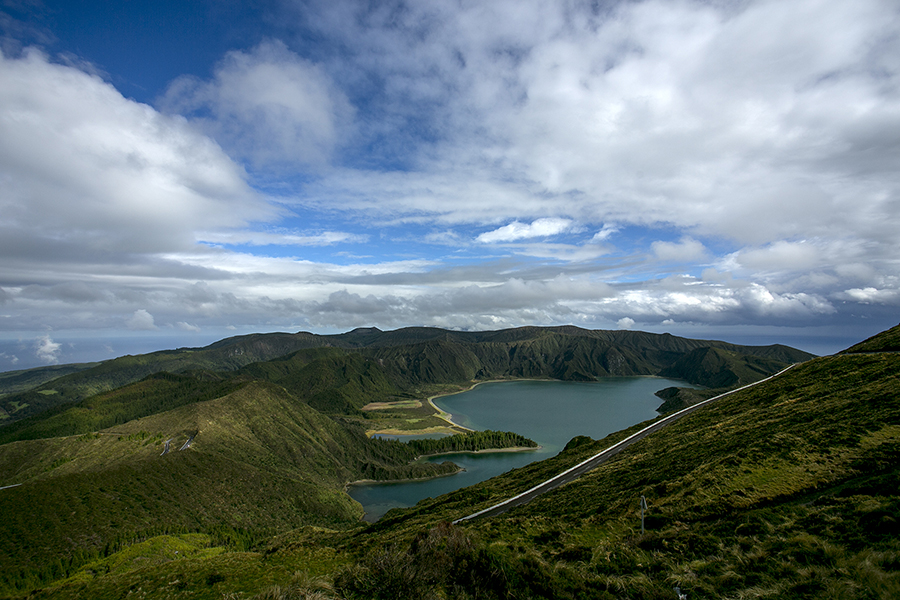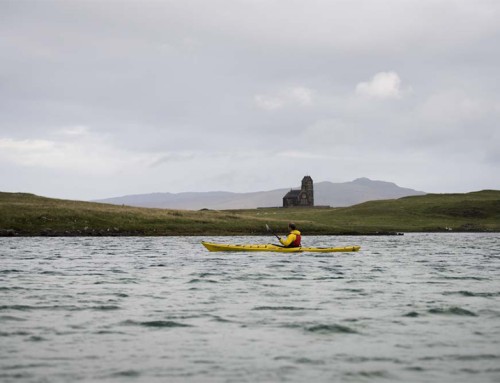The Azores are an outermost region of the European Union, comprising nine small volcanic islands located in the middle of the Atlantic Ocean between Europe and the EUA. This somewhat remote and exotic nature-based Portuguese destination holds an incredible combination of natural resources and social dynamics that create a unique wellbeing ambience. For that reason, sustainability has been a key factor in tourism planning and development, helping the region in achieving a paradise-like image.
Strategically, the Azores have strived to be positioned as an active nature-based destination, leveraging rich natural resources and combining the beautiful green volcanic scenery with the blue wild coolness of the Atlantic Ocean. Due to their geographic, orographic, demographic and social characteristics, the islands provide a privileged setting for slow travel and mindful experiences, on par with intense adventure activities with an exotic background. Even though the islands are not consistently perceived as a front-end wellbeing destination, the type of tourist behaviour that is possible to witness clearly fits on the wellbeing tourism scope. From lush green scenery and beautiful hiking trails to peaceful and picturesque rural settings, iron-rich thermal hot springs, delicious fresh seafood and exquisite cuisine, peaceful and welcoming people, and paradise-like coastal areas and beaches, the Azores can well be a trendy European destination on the post-pandemic future for wellbeing seekers.
Still, despite this great potential, since the islands are small and comprise fragile ecosystems, the Azores face great challenges to keep a well-balanced evolution of the tourism sector. A sustainable tourism approach has been at the core of the destination’s development strategy for more than a decade, aiming to respect the islands’ limitations regarding the carrying capacity and strive for the proper harmony between the economic, social and environmental dimensions. Sustainability in the Azores is taken very seriously by local authorities and it is considered a critical factor for the competitiveness of the region’s tourism. In 2007, National Geographic Traveller elected the Azores as the «Second-Best Islands for Sustainable Tourism», falling only behind Faroe Islands. The report included very relevant appraisals to the natural environment and cultural diversity in the region. However, it was also pinpointed that inappropriate development was beginning to appear and that really mobilized local decision markers to restate the importance of sustainable development. For instance, whale watching, one of the most emblematic tourism activities in the Azores, suffered some setbacks and limitations. In 2009, local authorities’ supervision efforts on whale watching activities were reinforced due to cases of non-compliance with regulations by a few tour operators. In 2010, the Regional Government established additional restrictions on the whale watching activities and limited access to licenses as a result of increasing pressure on the whales, dolphins, and their calves.
In 2008, the Azores Government announced the Spatial Planning for Tourism in the Region (POTRAA). It was branded as the fundamental mechanism to achieve the sustainable development of the tourism sector. In effect, it was an instrument to guide the various economic actors and discipline the administrative action, establishing the strategic tourism products and the evolution of the tourism supply until 2015. POTRAA established a Territorial Organization Model, with cartographic support, beyond suggesting a model for the distribution of the tourism supply in each island and a coordinated approach with municipal territorial management instruments. The plan clearly recommended the creation of Places with Specific Tourism Vocation, according to their natural, scenic and urban characteristics, in addition to special attention to more fragile ecologic areas, limiting their use for tourism. Although it has suffered some changes and adaptations throughout time, POTRAA is still in use. It is currently undergoing a major revision, that should be published in a near future, in order to be better adapted to a new paradigm in tourism derived from the partial liberalization of air travel in the region, which triggered the operation of low-cost carriers and greatly increased tourists’ inflows since 2015.
In 2016, the Azores Government presented a new strategy for tourism (PEMTA), but it was mainly based on competitive strategies and on a marketing approach rather than on sustainable development planning. Nature-based tourism, however, was selected as the priority product, complemented by nautical tourism, scenic and cultural tourism, and health and wellbeing tourism. Therefore, POTRAA’s revision has been considered critical to promote the protection of the islands’ environment and contribute to tourism development. It is set to avoid some of the impacts associated to the maturity and saturation stages of a destination life cycle, like polluted environment and landscapes, decay of heritage, water pollution, erosion, congestion and traffic, and improper urban development. In fact, the big tourists’ influxes from 2015 to 2019 have stimulated several investments in new hotels and tourist accommodation units – that need discipline to avoid oversupply and the destruction or deterioration of ecosystems -, beyond punctual issues related to hiking trails maintenance, traffic congestion, price increase in basic products (which has a big impact on the local cost of living) and even the need to limit or discipline the access to some popular local attractions. Prompt interventions from local authorities have been able to mitigate negative effects, but POTRAA’s revision will certainly bring enduring solutions.
The serious work and commitment in achieving sustainable development in the Azores are also evident on several UNESCO, RAMSAR, OSPAR and European Commission official classifications. Three of the nine islands are integrally classified as Biosphere Reserves by UNESCO, while a fourth is partially classified. The Azores have 13 sites inscribed in the Ramsar Convention on Wetlands of International Importance Especially as Waterfowl Habitat. There are 12 locations identified for the protection of the maritime environment under the OSPAR Convention. The Natura 2000 Network, an EU program, comprises more than 40 areas in the Azores, while there are two cultural sites categorized as UNESCO World Heritage. In addition, the Azores also have very specific and demanding Nature Parks (since 2008) and Geoparks (since 2010) systems, that cover all nine islands and privilege the appropriate management of protected areas. In fact, around 25% of the islands’ territory comprises protected areas, and since the islands are small and the land area is unevenly distributed between them, this creates additional challenges for spatial planning, urban development and tourism growth.
International Classification Systems
 | UNESCO World Heritage • Landscape of the Pico Island Vineyard Culture • Central Zone of the Town of Angra do Heroísmo in the Azores UNESCO | 2004 1983 |
 | Natura Network 2000 • 24 Special Areas of Conservation • 15 Special Protection Areas • 2 Sites of Community Importance European Commission | 1989 |
 | RAMSAR Sites • 13 Wetlands of International Importance RAMSAR Convention | 2012 2008 2005 |
 | Biosphere Reserves • Fajãs of São Jorge Island • Flores Island • Graciosa Island • Corvo Island UNESCO | 2016 2007 2007 2009 |
 | OSPAR Convention • 12 sítios identificados para proteção do ambiente marítimo do Atlântico Nordeste OSPAR Commission | 2010 |
Throughout the years, the Azores have been distinguished with multiple awards and international honours regarding sustainable tourism development. In fact, the region is ever-present in the Green Destinations’ Top-100 Sustainable Tourism Destinations since 2014 and is one of the best case studies of the Quality Coast program. Some of these honours have been awarded to special projects that create value for natural resources or local heritage.
| Award | Organization | Comments | Year |
|---|---|---|---|
| Coronavirus: Safest Destinations to visit in 2021 | European Best Destinations | - | 2021 |
| Europe’s Leading Adventure Tourism Destination | World Travel Awards | - | 2020 |
| Best Sustainable Destination in Europe | European Best Destinations | - | 2020 |
| Best practices in protecting underwater cultural heritage | UNESCO | UN Convention on the Protection of Underwater Cultural Heritage | 2019 |
| Top 10 Most Sustainable World Destinations | Green Destinations | Best of the Atlantic | 2018 |
| Top 100 Most Sustainable World Destinations | Green Destinations | - First place in 2014, with 8.9 points out of 10 - Second place in 2020’s Good Practice Stories - Communities & Culture category | 2014-2020 |
| Most beautiful landscapes in Europe | European Best Destinations | - | 2017 |
| Best Destinations to watch dolphins & whales in Europe | European Best Destinations | - | 2017 |
| QualityCoast Platinum Award | QualityCoast – Coastal and Marine Union of the European Union | 2014: First destination to be awarded the Platinum level | 2017-2020 2014-2016 |
| QualityCoast Gold Award | QualityCoast – Coastal and Marine Union of the European Union | Best Quality Coast Destination in Europe | 2013 |
| European Charter of Sustainable Tourism in Protected Areas | EUROPARC Federation | Lands of Priolo (Azores Bullfinch) | 2012 |
| 2017 | |||
| EDEN - European Destination of Excellence | European Commission | Faial’s Nature Park | 2011 |
| Best of the Best – Nature Award | European Commission | Granted to Project “Life Priolo,” which was developed between 2003 and 2008, focused on the protection and restoring of the risk vegetation of the laurel forest of the Azores | 2010 |
| Second Best Islands in the World for Sustainable Tourism | National Geographic Traveler | - | 2010 |
The pinnacle of this path was achieved in 2019, when the Azores became the first archipelago to be officially certified as a «Sustainable Destination» according to the certification program adopted by the Global Sustainable Tourism Council (GSTC)/Earth Check. During this long process, that started in 2017, several initiatives were implemented in order to promote more sustainable tourism development, including the creation of a Destination Management Organization (DMO), the Sustainability Charter of the Azores and a dedicated website, as well as many other tools and good practices that are actively contributing to better management of the islands’ tourism.
The Azores are, indeed, champions of sustainable tourism and have been developing consistent work in this regard for several years. This approach grants unique competitive advantages to the region. It preserves the island’s natural resources that create a lush nature-based destination while protecting local people and their culture and maintaining unique traditions, delicious food, amazing festivities and a welcoming, friendly and safe ambience. Due to all this, the Azores are a paradise for wellbeing tourism, slow travel and immersive experiences. There are nine very different islands, both in size and in peoples’ diversity, nature and culture. It is the right place for genuine experiences, far enough to be a safe remote location, but close enough to be easy and fast to get.





